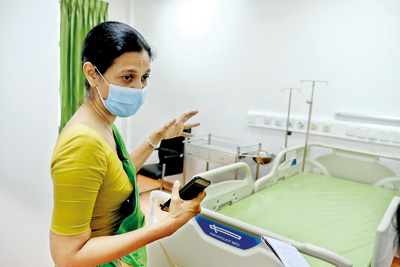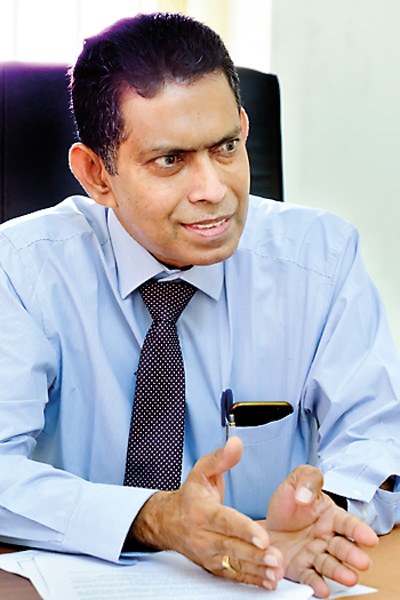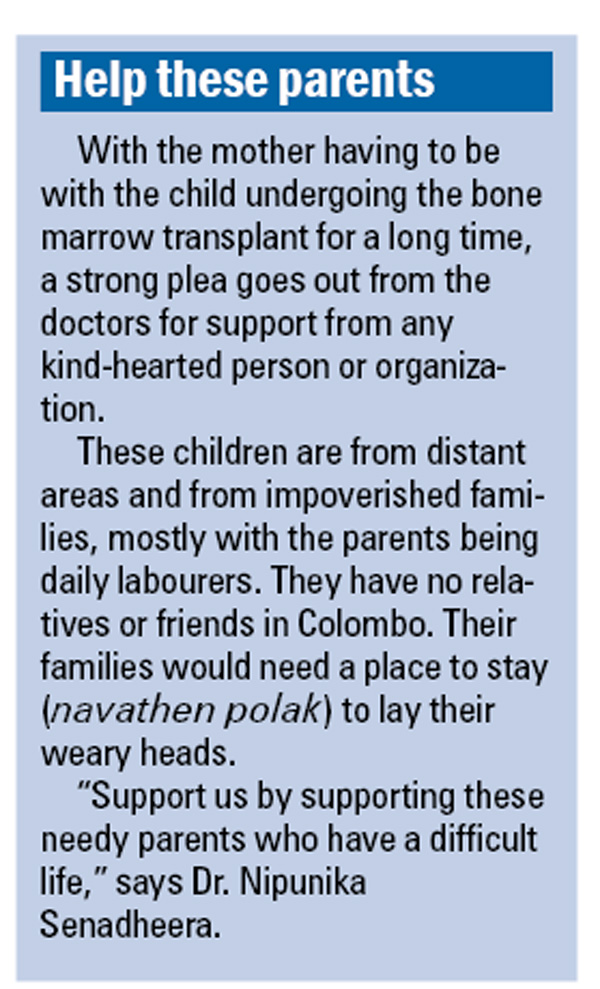News
Big step for SL’s health sector and children in dire need of Bone Marrow Transplant
A first in Sri Lanka’s state health service – providing hope for the country’s children.

Dr. Nipunika Senadheera showing around the brand new unit . Pix by Amila Gamage
Nestling within the premier Lady Ridgeway Hospital (LRH) for Children in Colombo, a Bone Marrow Transplant (BMT) Unit, a dire need of the country, is to be opened on Thursday (October 1) by Prime Minister Mahinda Rajapaksa.
The finishing touches are being carried out as the Sunday Times takes a walk around the Rs. 50 million, state-of-the-art BMT Unit where even the minutest detail has been thought of.
Timely is this two-room BMT Unit, for already 80 children are registered for this life-giving procedure. The little beneficiaries will mainly be children suffering from thalassaemia and also diseases such as aplastic anaemia.
Children with thalassaemia need blood transfusions all their life every two or three weeks and face complications such as iron chelation (excess iron in the blood). But the good news is that a bone marrow transplant will cure the disease, the Sunday Times learns, while the recommended first option of treatment for aplastic anaemia is also a bone marrow transplant.
Initially, the LRH will perform bone marrow transplants from bone marrow taken from a sibling after matching the HLA (human leukocyte antigen) and blood group. This is an allogeneic transplant, it is understood. Bone marrow is the soft, fatty tissue inside the bones which produces blood cells.
A child who has to undergo a bone marrow transplant would have to spend at least two weeks pre-procedure and four weeks post-procedure at the LRH along with his/her mother and the latter period would be in a 100% sterile environment as an infection would cause the death of the child.
A bone marrow transplant is a multidisciplinary effort guided by Haematologists with the input of Paediatricians, Transfusion Physicians and Microbiologists as the core team of specialists.
It is Consultant Haematologist Dr. Nipunika Senadheera who shows us around the well-equipped and ventilated unit on Tuesday, laughingly telling us that they paid more attention to setting up this unit than they did when they built their own homes.
Having heard by word-of-mouth that LRH is due to open the BMT Unit, desperate parents, from the far corners of the country, are already walking in and we see Consultant Haematologist Dr. Manori Prabashika in earnest conversation with a parent.

Dr. Deepal Perera
Walking through the BMT Unit, the Sunday Times learns that half the funds have been expended on the vital airway system with hepa-filters and measures to ensure that there would be positive pressure within the two rooms where the bone marrow transplant recipients would spend a month after the procedure in an infection-free environment.
A pleasing green is on the walls and Dr. Senadheera pulls back the green curtains to reveal through the large window, a wall with colourful trees, flowers and bees painted on it that the child would see from his/her bed and from the next room a jungle setting complete with an elephant, lion, tiger, rhino and hippo.
We follow her to peek at the chemo-prep room, the stores, the room where the dirty washing would be kept to be taken out, the pantry and doctors’ room as they would have to spend long hours here.
“All protocols have been made,” says Dr. Senadheera, explaining that they have a wonderful and dedicated team of five Medical Officers, two nurses with eight more being needed, laboratory technicians and pharmacists. A very important job would be handled by the three minor staff for they would keep the environment from roof-to-floor disinfected.
Dr. Senadheera is appreciative of the support extended by the Health Ministry, the LRH Director Dr. G. Wijesuriya and LRH colleagues as well as the Central Engineering Consultancy Bureau (CECB) and the input of a team headed by Prof. Vikram Mathews of the Christian Medical College in Vellore, Tamil Nadu, India.
“We have sent people for training to the Christian Medical College and their experts will be with us virtually when we perform the first bone marrow transplant at the LRH,” she adds.
| Plight of children who need a bone marrow transplant | |
| “This is our contribution to World Children’s Day celebrated in Sri Lanka on Thursday,” says Consultant Paediatrician Dr. Deepal Perera of Ward 2 who talks of the plight of children who had to seek bone marrow transplants either in the private sector or in India or Singapore at an exorbitant cost of about Rs. 5 million, Rs. 10 million and Rs. 20 million respectively. Now they face a different challenge due to COVID-19 and travel restrictions which prevent them from going abroad.So the LRH’s BMT Unit would be beneficial for these children, he says. Dr. Perera explains that even though with screening and awareness in areas such as Kurunegala, Anuradhapura, Polonnaruwa, Matale, Kandy, Badulla, Moneragala and some pockets in Hambantota, the number of children being born with thalassaemia is decreasing, there are around 2,000 who are already affected with around 50 new patients joining the list each year. Urging that prevention of thalassaemia is the best option, he says that countries such as Greece and Cyprus have done so by making people aware of the need to get screened to see whether they are carriers, before marriage. If two carriers marry, the chances of having a child who has thalassaemia will be 1 in 4.
|


